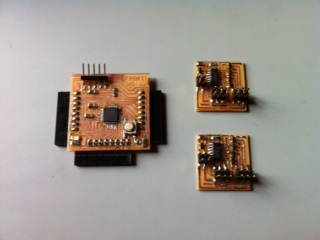FabLab Academy 2012
Manchester Lab
David Forgham-Bailey
This week's task was to automate our machine - the FabScan3D_mod.
The electronics design has yet to be finalised. The aim is to produce
electronics which can be easily replicated by any FabLab.
Currently we are designing a system which utilises components from the
Fab inventory.
We aim to use the A4985 Stepper Driver Chip (620-1344-1-ND) - and the
USB to Serial chip (768-1007-1-ND) - with the control chip ATTiny 44 -
or the ATMega 328 (both in the inventory).
In the meantime I manufactured the Fabkit i/o
(aka Fabduino) and the hello.stepper
boards to create a development rig to test out software routines for
control of the two stepper motors and the Laser.

Programming the Fabkit proved difficult - the chip used was the Mega328
but Arduino only recognises the Mega328P chip which is fitted to the
commercial Arduino boards.
At one stage I managed to get the bootloader to complete - (by editing
avrdude.cfg), and the led on the Fabkit flashed ... however when the
FTDI cable was attached the board did not function...
I decided to try to reload the bootloader but this time it failed to
complete...(bad decision)..
Upon further investigation I found that the FTDI connectors did not
match the FTDI cable - Rx/TX wrong way round on the board... More
work required to bootload the board
correctly, and resolve the FTDI issue...
I decided to use a commercial Arduino Mega 2560 - with two stepper
motors from the Fab inventory (PF35T-48L4) - connected to pins 8-11 and
4-7, and a diode in place of the Laser - connected to pin13. Using the
Arduino programme I made up a routine to sequence the motors and the
led - stepper 1 moves one step - the laser turns on - the second
stepper moves through 1/4 rev and returns - then the first stepper
moves again to repeat until one full revolution is achieved... (these
steppers can be driven directly from the Arduino and have 48 steps per
rev - the motors we will use in the final machine will need a 12v
supply and have 200 steps per rev - so the routine will need to be
modified accordingly.

 video
video
Once we have designed and manufactured the final electronics boards,
this routine will be created in 'c' or Python.


 video
video